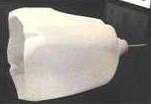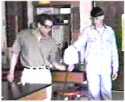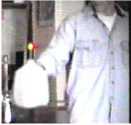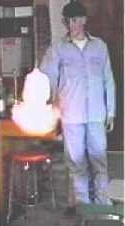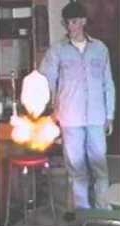Making Water in a Milk Jug |
|
An interesting way to synthesize water uses a regular one gallon milk jug. Cut out the bottom of the jug. Find a rubber stopper that will fit the mouth of the jug. Insert a short length of glass tubing through the stopper. Ask for a student volunteer (don't tell them what happens). Have a student hold the jug right-side up with arm extended. Using some rubber hose attached to a compressed cylinder of hydrogen, displace the air from the inside of the jug with hydrogen. Use a moderate flow rate of hydrogen. Have a match ready and light the hydrogen that is escaping from the top of the glass tubing. If your students know anything about hydrogen, they will immediately recoil in anticipation of an explosion. However, there is not enough oxygen present to allow a quick and complete reaction. Instead you get a slow burn of hydrogen as it escapes the jug and finds some oxygen molecules. Your students (including your volunteer) will begin to relax and become bored with this modest flame. Don't worry. As hydrogen is consumed out the top of the jug, air is reentering the bottom of the jug. When the ratio inside the jug approaches 2 hydrogen: 1 oxygen (2H2 + O2 ---> 2H2O) the hydrogen wick will actually shrink in size and then begin to flicker as if it is going to go out. At that moment, the flame is drawn inside the jug and causes a large fireball to shoot out the bottom of the jug. When the students overcome their initial shock, they will ask you to repeat this cool demo. |
|
|
|
|
|
|
|
|
|
|
|
